Steel Cut Oatmeal vs Oatmeal: Is Rolled Oats Better?
As a Certified Health Coach many clients ask me about the many different types of oatmeal including steel cut. This may make it confusing about which one to pick. Knowing which one is better may sway your decision. Therefore, is steel-cut oatmeal better than rolled oats?
Steel cut oatmeal is better than rolled oats due to its lower glycemic index score. Steel cut oats are less processed by the manufacturer and are thicker than rolled oats. For this reason, steel cut oatmeal is absorbed and digested slower reducing sugar spikes.
This article will explain all the differences between the two including their nutrients and glycemic index scores. In addition, I’ll examine their tastes, textures, costs and health benefits.
In addition to coaching clients, I’ve purchased, researched and consumed both prior to, during and after writing this article. I personally consume both varieties on a regular basis.
The Difference Between Steel Cut Oats and Rolled Oats
Take a quick glance of the cereal aisle shelf, and you’ll likely see four different types of oatmeal very quickly. Two of them is steel cut and rolled oats. Let’s find out how they differ from each other.
The main difference is steel cut oatmeal takes longer to cook than rolled oats. Steel cut oatmeal takes 20-30 minutes to cook while regular oatmeal takes 5 minutes. Steel cut oatmeal has a heartier, chewier texture. Rolled oats are more processed by the manufacturer.
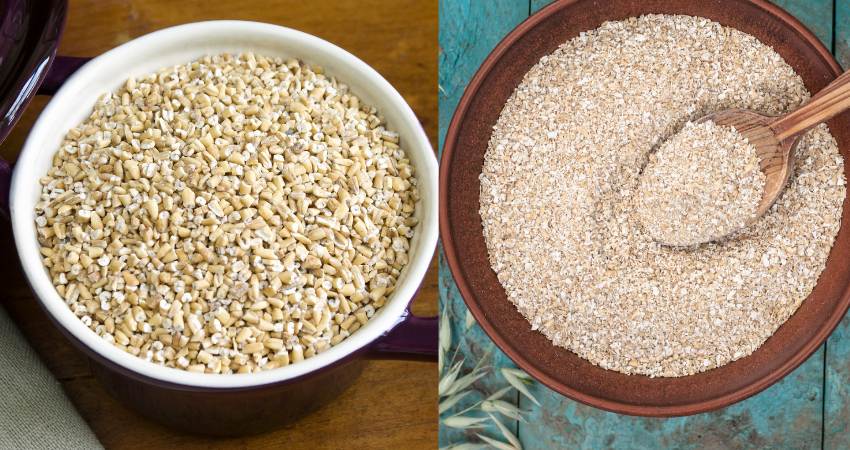
Other differences:
Steel Cut Oats
- Oats steel-cut are processed by chopping the whole oat groat with sharp metal blades and have a tougher texture prior to cooking.
- Cut smaller and not flattened or rolled.
- Chewier.
- Tastes nuttier.
- Take 20-30 minutes to cook on the stovetop.
- Sometimes called Irish oatmeal.
Rolled Oats
- Rolled oats is made by steaming the oat groats until they’re soft. The groats are then rolled into flakes.
- Are rolled and flattened.
- Is less chewy than steel cut but more chewier than instant or quick oats.
- Can absorb water quicker and take 5 minutes to cook after adding them to boiling water.
- May be called oatmeal, oats rolled, rolled oats, instant oats or old-fashioned.
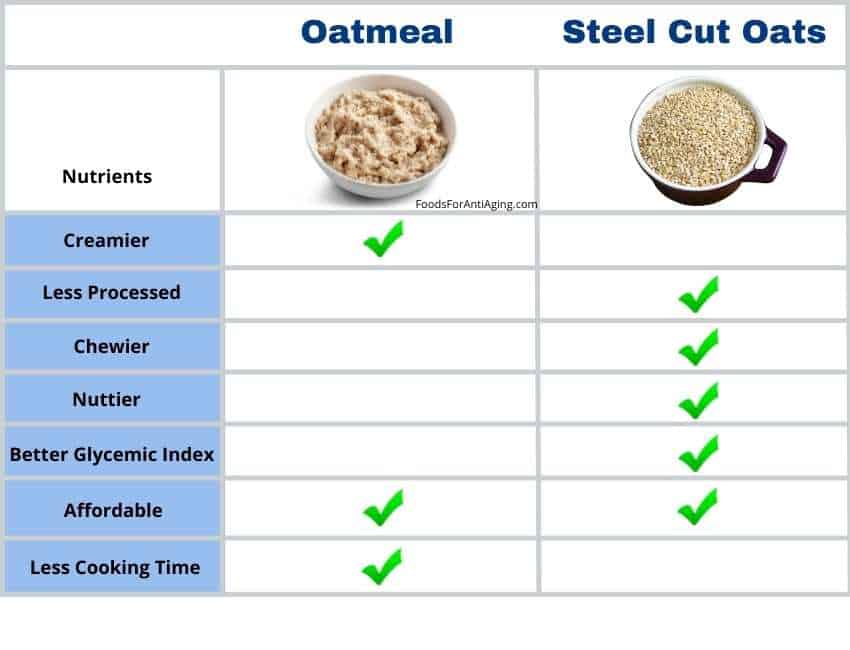
The Pros and Cons
Steel Cut Oats Pros
- Less processed than regular.
- Heartier texture and taste.
- Lower glycemic index.
Steel Cut Oats Cons
- Steel-cut oats take longer to cook.
- May be too chewy or coarser for some people who prefer creamier.
Rolled Oats Pros
- Less cooking time.
- Medium texture and less chewy.
- Heartier.
Rolled Oats Cons
- More processed.
- Higher glycemic index.
- Too chewy for those who prefer instant or creamier.
Nutritional Comparison
The following table is a side-by-side comparison of the nutrients contained in both.
| Oatmeal (100 g) | Steel Cut Oats (100 g) | |
| Calories | 379 | 360 |
| Protein | 13.2 g | 13.3 g |
| Carbohydrates | 67.7 g | 67.8 g |
| Fiber | 10.1 g | 9.3 g |
| Fat | 6.52 g | 7.19 g |
| Sugar | 0.99 g | 1.00 g |
| Vitamin A | 0 IU | 0 IU |
| Beta-carotene | 0 mcg | 0 mcg |
| Vitamin C | 0 mg | 0 mg |
| Vitamin B1 (Thiamin) | 0.46 mg | 1.00 mg |
| Magnesium | 138 mg | 136 mg |
| Phosphorous | 410 mg | 460 mg |
| Potassium | 362 mg | 384 mg |
| Iron | 4.25 mg | 3.81 mg |
| Copper | 0.39 mg | 0.31 mg |
| Calcium | 52 mg | 52 mg |
| Zinc | 3.64 mg | 3.60 mg |
Both oats contain the same types of nutrients. At first it’s difficult to determine which one provides a higher percentage than the other. This causes many people to wonder which is healthier.
Steel-cut oats are healthier than rolled oats due to its lower glycemic index. Steel cut oats are digested and absorbed more slowly. For this reason there is a slower rise in blood sugar and less sugar spikes. The percentage of nutrients in both oats are similar.
Regular oatmeal is healthy also and should not be discounted. Both are highly nutritious and excellent sources of fiber, protein and minerals. The variety chosen may come down to taste, preparation time or preference.
Keep reading down further in the article for more information about the glycemic index.
I use both and alternate between the two varieties. More often I consume the regular because it takes less time to prepare.
Find out the nutrient difference between instant and regular in my article.
Cut Oats vs Rolled Oats: Taste and Texture
Many times people choose one food over the other because of its taste or according to their mood.
Since there are some similarities between the two oats, like both being oats, many people wonder if they taste the same.
Steel-cut oats tastes nuttier than rolled oats. The bigger difference between the two is the texture. Oatmeal is creamier than the chewier, more coarse steel cut.
Steel cut oats taste different due to its thicker and less processed oats. Rolled oats are steamed and rolled which flattens them more.

To conduct some original research, I polled some of my readers and people in food groups I belong to. I asked, which one do you prefer for breakfast?
- 72% said they preferred the taste of regular rolled oats.
- 23% said they preferred the taste of steel-cut oats.
- 5% said they had no preference.
For more original research I thought it would be fun to setup a taste test at home. There, three out of four people chose the regular oats as the better taste.
In the poll and in my own taste test, regular rolled oats was the clear cut winner in the battle of taste.
Check out the pros and cons of overnight vs regular in my article.
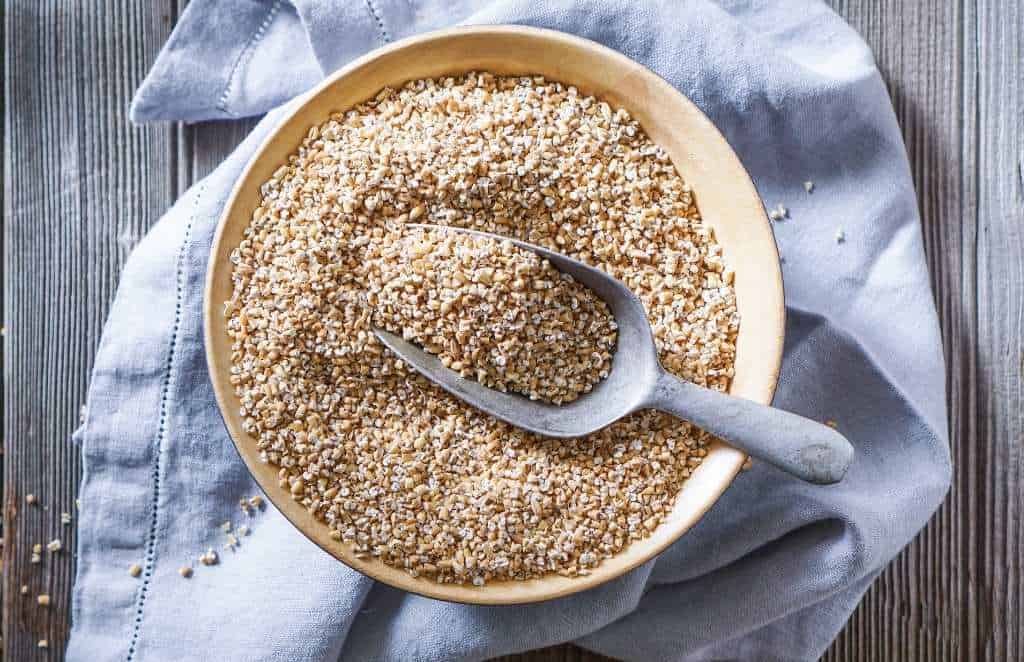
Costs of Cut and Rolled
It seems every time I pay at the supermarket the price is higher than the last time. Not only that but it also seems I have less groceries in my shopping cart.
The cost of food certainly matters to most people. The price may sway your decision about which oats to use in your meals more often. Therefore, let’s take a close look at the prices of both.
Steel-cut oats and rolled oats have a similar price per serving. The average price for steel cut oatmeal is $0.18 per 40 gram serving. The average price for regular oatmeal is $0.18 per 40 gram serving.
To conduct my own original research, I visited various different stores to compare the price of both.
I first visited the Shoprite supermarket for the prices:
- Wholesome Pantry Organic old-fashioned regular
- $2.49 per 18 oz container (13 servings) equaling $0.19 per 40 g serving
- Wholesome Pantry Organic Steel-Cut Oats
- $3.49 per 30 oz container (21 servings) equaling $0.17 per 40 g serving
I then checked Walmart:
- Quaker Old Fashioned Oats
- $4.98 per 42 oz container (30 servings) equaling $0.17 per 40 g serving
- Quaker Steel-Cut Oats
- $4.00 per 30 oz container (21 servings) equaling $0.19 per 40 g serving
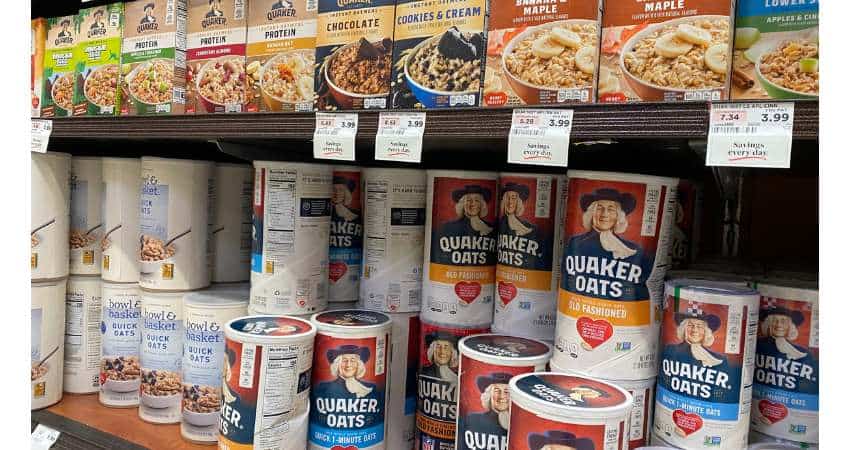
Find out if granola had more nutrients in my comparison article.
Storage
Whichever you choose or have on hand, proper storage is important. How you either one can affect how long they last before going bad and how they taste. Therefore, let’s examine how to store both varieties.
Store unopened steel-cut oats and rolled oats in a cool, dry place away from the heat and sun. Once opened, they should be tightly covered in its original container, glass or plastic container or resealable bag.
Either one cooked should be refrigerated in a sealed container up to 3-4 days.
Opened, resealed can be stored up to one year. Always check the dates on the packaging. Typically, the “best if used by date” is a quality suggestion3.
Find out how quinoa compared in my article.
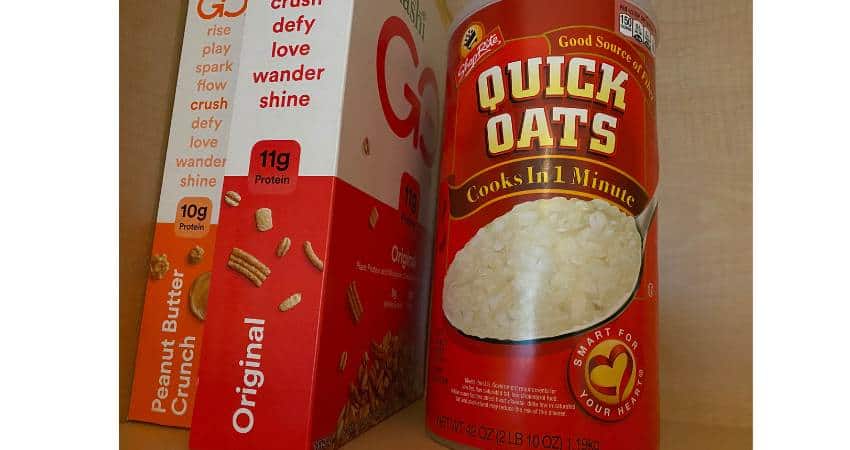
Glycemic Index
The Glycemic Index (GI) is a scale measuring how fast a particular food raises the blood sugar in the blood4. Blood sugar spikes can lead to health complications with the heart, nerves, kidneys and eyes5.
Foods on the GI scale are categorized as:
- Low-GI foods: 55 or under
- Medium-GI foods: 56-69
- High-GI foods: 70 or over
How blood sugars levels are affected:
- Foods with a glycemic index 70 or more cause a quicker spike in blood sugar levels.
- Foods with a glycemic index 56 to 69 cause a moderate spike in blood sugar levels.
- Foods with a glycemic index 55 or less cause a slow spike in blood sugar levels.
Having more knowledge of the glycemic index of food and how it raises blood sugar, many people wonder which type has a better score.
Steel-cut oats, they have a lower glycemic index than rolled oats due to the extra processing of the regular oats. Steel cut oatmeal has a glycemic index of 42 while rolled regular oats have a glycemic index of 55.
They have a lower GI because they are the least processed. Rolled oats are a little higher because they’ve been partially cooked. Quick or instant have been steamed and rolled into thinner pieces to cook quicker. This process increases their GI.
Find out if grits has the better satiety in my article.
Health Benefits
If you’re seeking a healthy breakfast option, you really can’t go wrong with either type. The nutrition content only varies slightly between both varieties.
The following are the benefits received from the nutrients contained in both.
Weight Loss
Steel-cut oats and rolled oats are good for weight loss due to their high fiber content and satiety score. Fiber rich is beneficial for weight loss because studies have shown adding 30 grams of fiber to your diet can help you lose extra weight.
Another reason both are good for weight loss is their satiety index score.
The satiety index was developed in 1995 from a study which tested 38 foods. The foods were ranked how they satisfied a person’s hunger. Foods scoring under 100 are considered less filling and foods scoring above 100 are considered more filling ((National Center for Biotechnology Information: A satiety index of common foods)).
The table below shows the satiety scores of some foods.
| Food | Satiety Index Score |
| Muesli | 100% |
| Brown rice | 132% |
| Lentils | 133% |
| Wholemeal Bread | 157% |
| Brown pasta | 188% |
| Oatmeal w/milk | 209% |
Of all the 38 foods, oats scored the fourth highest only beat by boiled potatoes, ling fish and oranges.
Potassium
- Both oats are a good source of potassium.
Some medical experts recommend the potassium to sodium ratio of 4:1. Consuming too much sodium or not enough potassium throws off the delicate balance the kidneys need to remove the excess water6.
Potassium helps the body get rid of excess sodium reducing fluid build-up. These help keep systolic and diastolic blood pressure lower ((American Heart Association: How Potassium Can Help Control High Blood Pressure)).
According to Harvard Health, a number of studies have shown a connection between low potassium levels and high blood pressure7. The more potassium, the more sodium your body will lose.
Calcium
- Both varieties contain the same amount of calcium.
Calcium is important for the heart and blood pressure. Harvard Health reports calcium helps maintain blood pressure by helping in the controlling of the relaxing and tightening of blood vessels8.
Calcium also helps the following:
- Help the muscles to function properly.
- Helps nerve function.
- Build and maintain strong bones.
Find out how brown rice compared in my article.
Fiber
- Regular oats contains a little more fiber..
Both foods are high in soluble fiber, which is helpful for many reasons ((National Center for Biotechnology Information: Mechanisms linking dietary fiber, gut microbiota and colon cancer prevention)). What makes fiber soluble is it dissolves in water.
Soluble fiber is known for the following:
- Help overall digestive health.
- Decrease the risk of diabetes by managing the blood glucose levels.
- Helps avoid constipation and have a more regular stool.
- Aids greatly in weight management because it allows you to feel full faster and eat less.
Magnesium
- Both types are an excellent source of magnesium.
Magnesium helps keep blood pressure levels stable and balanced. Recent scientific research examined previous studies and concluded magnesium supplementation decreased systolic and diastolic blood pressure9.
Magnesium helps control the following:
- Insomnia
- Muscle
- Blood pressure
- Blood sugar
- Nerve function
In the heart and muscles, magnesium competes with calcium to help the muscles relax after contracting. When the body is low in magnesium, calcium can over stimulate the heart muscle’s cells causing a rapid or irregular heartbeat10.
One reason many people supplement with magnesium in the evening is because it helps calm the whole body including blood vessels.
Is it better than eggs? Find out in my article here.
Phosphorus
- Steel cut contains a little more phosphorus.
Phosphorus has been shown in scientific studies to help with the following:
- Help the body store and manage energy.
- Promote healthy nerve conduction.
- Promote bone and teeth strength.
- Muscle contraction.
- Muscle recovery.
- Help the kidneys remove waste.
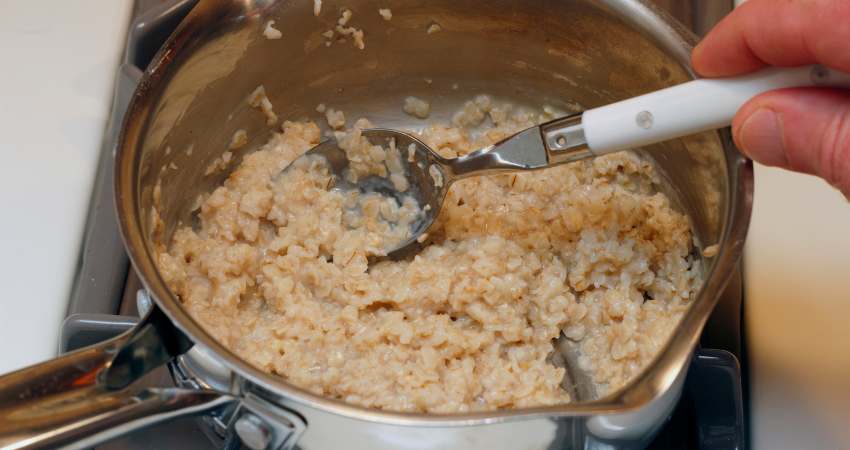
Gluten-Free
Both types are made from oats which are naturally gluten-free. However, the product you choose may not be gluten free due to cross-contamination. Always check the label to determine if its gluten free.
Important: Although gluten free, they may come in contact with gluten-containing grains in storage or during transportation. Most of the Quaker products have solved this issue and label those products gluten free. Always check the label to determine if its gluten free.
Iron
Much higher in iron than other grains, it is an excellent choice if you need getting your daily value of iron. Iron is essential in the creation of red blood cells and is a necessary part of any healthy diet.
Iron is also vital for growth and development, as some hormones need iron to be appropriately balanced11.
Find out how it compared to Cream of Wheat in my comparison article.
If you have any questions about this article don’t hesitate to email us. You can find an email on our contact page.
Read Next – More Oatmeal Food Articles!
Muesli vs Oatmeal – What’s The Difference? Let’s Compare
Oatmeal vs Rice: Which Is More Healthy? (We Find Out)
Oatmeal vs Cereal – Which is Better? Let’s Compare
- USDA: Cereals, oats, regular and quick, not fortified, dry [↩]
- USDA: Quaker Steel Cut Oats [↩]
- Michigan State University: Dry oatmeal needs careful handling [↩]
- Harvard Health Publishing: Glycemic index for 60+ foods [↩]
- National Institute of Diabetes and Digestive and Kidney Diseases: Know Your Blood Sugar Numbers: Use Them to Manage Your Diabetes [↩]
- National Center for Biotechnology Information: The Effect of the Sodium to Potassium Ratio on Hypertension Prevalence: A Propensity Score Matching Approach [↩]
- Harvard Health: Potassium lowers blood pressure [↩]
- Harvard Health: Key minerals to help control blood pressure [↩]
- National Center for Biotechnology Information: Effect of magnesium supplementation on blood pressure: a meta-analysis [↩]
- National Institutes of Health: Magnesium [↩]
- National Institutes of Health: Iron [↩]
